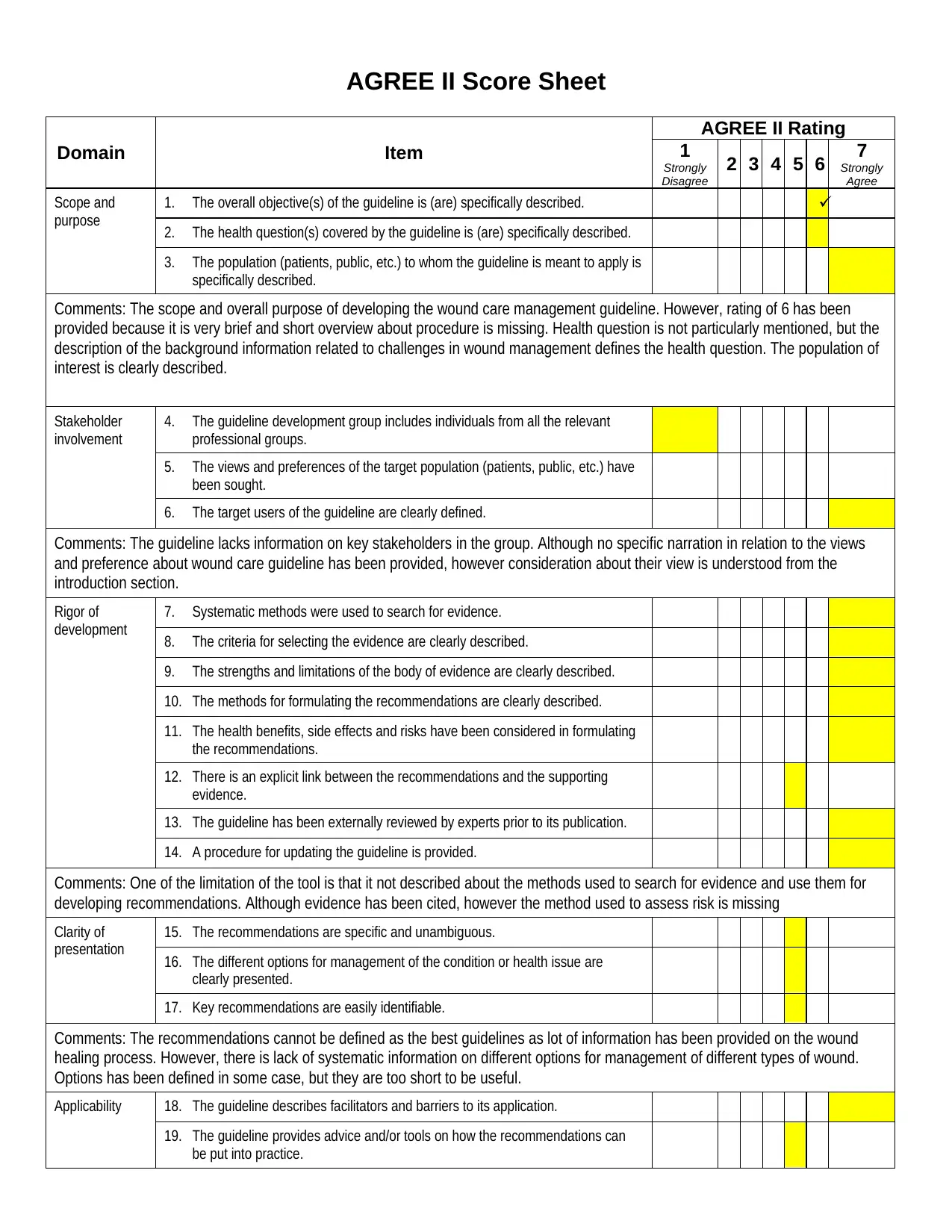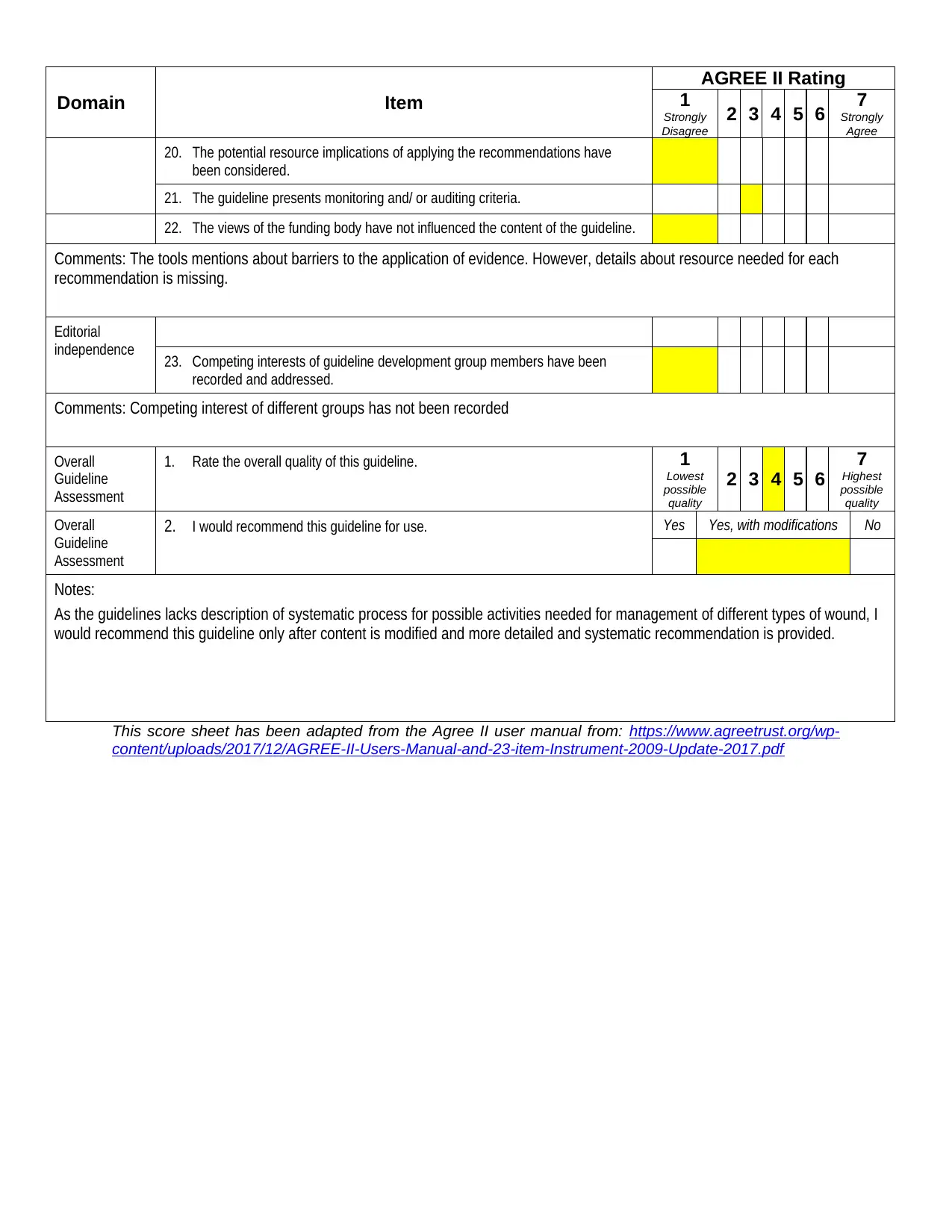NURS2007 Assignment 3: Critique of Wound Care Clinical Guidelines
VerifiedAdded on 2023/06/03
|2
|748
|224
Report
AI Summary
This report presents a critique of a wound care management guideline, assessed using the AGREE II tool. The analysis focuses on the guideline's scope, stakeholder involvement, rigor of development, clarity of presentation, applicability, and editorial independence. The report highlights strengths ...

AGREE II Score Sheet
Domain Item
AGREE II Rating
1
Strongly
Disagree
2 3 4 5 6 7
Strongly
Agree
Scope and
purpose
1. The overall objective(s) of the guideline is (are) specifically described.
2. The health question(s) covered by the guideline is (are) specifically described.
3. The population (patients, public, etc.) to whom the guideline is meant to apply is
specifically described.
Comments: The scope and overall purpose of developing the wound care management guideline. However, rating of 6 has been
provided because it is very brief and short overview about procedure is missing. Health question is not particularly mentioned, but the
description of the background information related to challenges in wound management defines the health question. The population of
interest is clearly described.
Stakeholder
involvement
4. The guideline development group includes individuals from all the relevant
professional groups.
5. The views and preferences of the target population (patients, public, etc.) have
been sought.
6. The target users of the guideline are clearly defined.
Comments: The guideline lacks information on key stakeholders in the group. Although no specific narration in relation to the views
and preference about wound care guideline has been provided, however consideration about their view is understood from the
introduction section.
Rigor of
development
7. Systematic methods were used to search for evidence.
8. The criteria for selecting the evidence are clearly described.
9. The strengths and limitations of the body of evidence are clearly described.
10. The methods for formulating the recommendations are clearly described.
11. The health benefits, side effects and risks have been considered in formulating
the recommendations.
12. There is an explicit link between the recommendations and the supporting
evidence.
13. The guideline has been externally reviewed by experts prior to its publication.
14. A procedure for updating the guideline is provided.
Comments: One of the limitation of the tool is that it not described about the methods used to search for evidence and use them for
developing recommendations. Although evidence has been cited, however the method used to assess risk is missing
Clarity of
presentation
15. The recommendations are specific and unambiguous.
16. The different options for management of the condition or health issue are
clearly presented.
17. Key recommendations are easily identifiable.
Comments: The recommendations cannot be defined as the best guidelines as lot of information has been provided on the wound
healing process. However, there is lack of systematic information on different options for management of different types of wound.
Options has been defined in some case, but they are too short to be useful.
Applicability 18. The guideline describes facilitators and barriers to its application.
19. The guideline provides advice and/or tools on how the recommendations can
be put into practice.
Domain Item
AGREE II Rating
1
Strongly
Disagree
2 3 4 5 6 7
Strongly
Agree
Scope and
purpose
1. The overall objective(s) of the guideline is (are) specifically described.
2. The health question(s) covered by the guideline is (are) specifically described.
3. The population (patients, public, etc.) to whom the guideline is meant to apply is
specifically described.
Comments: The scope and overall purpose of developing the wound care management guideline. However, rating of 6 has been
provided because it is very brief and short overview about procedure is missing. Health question is not particularly mentioned, but the
description of the background information related to challenges in wound management defines the health question. The population of
interest is clearly described.
Stakeholder
involvement
4. The guideline development group includes individuals from all the relevant
professional groups.
5. The views and preferences of the target population (patients, public, etc.) have
been sought.
6. The target users of the guideline are clearly defined.
Comments: The guideline lacks information on key stakeholders in the group. Although no specific narration in relation to the views
and preference about wound care guideline has been provided, however consideration about their view is understood from the
introduction section.
Rigor of
development
7. Systematic methods were used to search for evidence.
8. The criteria for selecting the evidence are clearly described.
9. The strengths and limitations of the body of evidence are clearly described.
10. The methods for formulating the recommendations are clearly described.
11. The health benefits, side effects and risks have been considered in formulating
the recommendations.
12. There is an explicit link between the recommendations and the supporting
evidence.
13. The guideline has been externally reviewed by experts prior to its publication.
14. A procedure for updating the guideline is provided.
Comments: One of the limitation of the tool is that it not described about the methods used to search for evidence and use them for
developing recommendations. Although evidence has been cited, however the method used to assess risk is missing
Clarity of
presentation
15. The recommendations are specific and unambiguous.
16. The different options for management of the condition or health issue are
clearly presented.
17. Key recommendations are easily identifiable.
Comments: The recommendations cannot be defined as the best guidelines as lot of information has been provided on the wound
healing process. However, there is lack of systematic information on different options for management of different types of wound.
Options has been defined in some case, but they are too short to be useful.
Applicability 18. The guideline describes facilitators and barriers to its application.
19. The guideline provides advice and/or tools on how the recommendations can
be put into practice.
Paraphrase This Document
Need a fresh take? Get an instant paraphrase of this document with our AI Paraphraser

Domain Item
AGREE II Rating
1
Strongly
Disagree
2 3 4 5 6 7
Strongly
Agree
20. The potential resource implications of applying the recommendations have
been considered.
21. The guideline presents monitoring and/ or auditing criteria.
22. The views of the funding body have not influenced the content of the guideline.
Comments: The tools mentions about barriers to the application of evidence. However, details about resource needed for each
recommendation is missing.
Editorial
independence 23. Competing interests of guideline development group members have been
recorded and addressed.
Comments: Competing interest of different groups has not been recorded
Overall
Guideline
Assessment
1. Rate the overall quality of this guideline. 1
Lowest
possible
quality
2 3 4 5 6
7
Highest
possible
quality
Overall
Guideline
Assessment
2. I would recommend this guideline for use. Yes Yes, with modifications No
Notes:
As the guidelines lacks description of systematic process for possible activities needed for management of different types of wound, I
would recommend this guideline only after content is modified and more detailed and systematic recommendation is provided.
This score sheet has been adapted from the Agree II user manual from: https://www.agreetrust.org/wp-
content/uploads/2017/12/AGREE-II-Users-Manual-and-23-item-Instrument-2009-Update-2017.pdf
AGREE II Rating
1
Strongly
Disagree
2 3 4 5 6 7
Strongly
Agree
20. The potential resource implications of applying the recommendations have
been considered.
21. The guideline presents monitoring and/ or auditing criteria.
22. The views of the funding body have not influenced the content of the guideline.
Comments: The tools mentions about barriers to the application of evidence. However, details about resource needed for each
recommendation is missing.
Editorial
independence 23. Competing interests of guideline development group members have been
recorded and addressed.
Comments: Competing interest of different groups has not been recorded
Overall
Guideline
Assessment
1. Rate the overall quality of this guideline. 1
Lowest
possible
quality
2 3 4 5 6
7
Highest
possible
quality
Overall
Guideline
Assessment
2. I would recommend this guideline for use. Yes Yes, with modifications No
Notes:
As the guidelines lacks description of systematic process for possible activities needed for management of different types of wound, I
would recommend this guideline only after content is modified and more detailed and systematic recommendation is provided.
This score sheet has been adapted from the Agree II user manual from: https://www.agreetrust.org/wp-
content/uploads/2017/12/AGREE-II-Users-Manual-and-23-item-Instrument-2009-Update-2017.pdf
1 out of 2
Related Documents
Your All-in-One AI-Powered Toolkit for Academic Success.
+13062052269
info@desklib.com
Available 24*7 on WhatsApp / Email
![[object Object]](/_next/static/media/star-bottom.7253800d.svg)
Unlock your academic potential
© 2024 | Zucol Services PVT LTD | All rights reserved.





